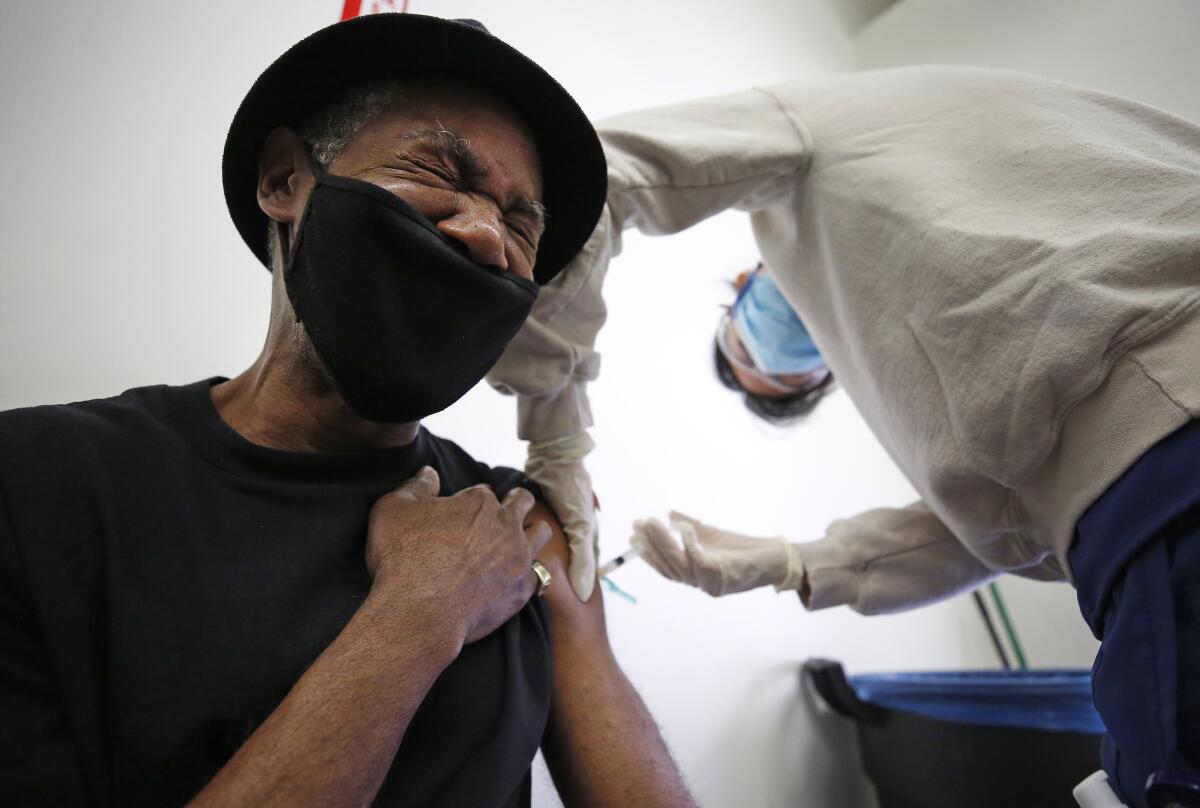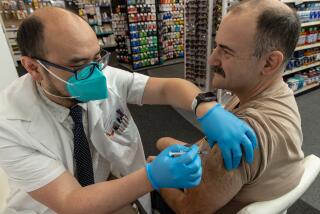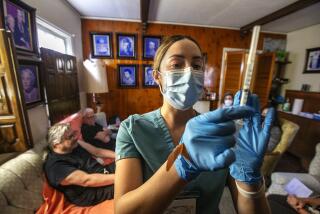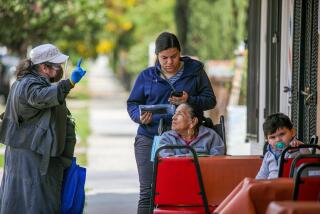L.A. Latino, Black seniors fall behind in COVID-19 vaccine access compared with whites

- Share via
Black, Latino and Native American seniors in Los Angeles County are receiving COVID-19 vaccinations at a lower rate than white, Asian American and Pacific Islander seniors, according to data released Monday.
The findings raised new concerns about inequity in the troubled rollout of vaccines for those 65 and older and added pressure on county leaders to do a better job of getting communities of color immunized.
Only 7% of Black residents age 65 and over have received at least one dose of the COVID-19 vaccine, the lowest percentage of any racial and ethnic group and less than half the comparable figure for white senior residents. About 9% of Native American seniors and 14% of Latino seniors have received at least one dose.
By contrast, 17% of white senior residents have received at least one shot, as have 18% of Asian American and 29% of Native Hawaiian/Pacific Islander seniors.
L.A. County seniors who weren’t part of the earlier priority groups of healthcare workers and residents of long-term care facilities became eligible to receive COVID-19 vaccines starting Jan. 20.
More than 1 million doses cumulatively have been administered in L.A. County.
“We’re alarmed by the disproportionality we’re seeing in who has received the vaccine,” said L.A. County Public Health Director Barbara Ferrer, who expressed particular concern about the “glaring inadequacy in the vaccine rollout to date” to Black residents.
“This new data shows us that we need to make it much easier for Native American, Black and Latinx residents and workers to be vaccinated in their communities by providers they trust,” Ferrer said Monday. “This is a top priority for the Department of Public Health. And we’re going to continue to work with our community partners to ensure that we’re not only getting everyone vaccinated quickly, but we’re addressing the need to provide easier access to neighborhood sites and better access to accurate information about the vaccines.”
Ferrer said the county is committed to increasing the number of vaccination sites in the hardest-hit areas. In all, there are 365 sites offering vaccinations this week. Ten sites were added for the Eastside and South L.A., bringing the total number of sites in those areas to 14 and 35, respectively.
Ferrer said the county is also organizing mobile teams to start bringing vaccinations next week to residents of senior housing and to senior centers in the hardest-hit areas.
“We’ll also have community health workers in the highly impacted communities, who at times may be going block-by-block to provide information to residents about how to get vaccinated, help them sign up and to dispel myths and misinformation about the vaccine,” Ferrer said.
The disparity in those receiving vaccinations is not limited to L.A. County. In Northern California’s most populous county, Santa Clara, 18% of Latino and Black seniors have received at least one dose, while 28% of white seniors and 40% of Asian American seniors have received at least one.
L.A. County Supervisor Hilda Solis noted that racial and ethnic groups that have suffered the worst in terms of coronavirus cases, hospitalizations and deaths are receiving fewer vaccinations.
“This is completely unacceptable. And we’ll be sharing some of those changes to our vaccine rollout in the coming days to ensure that it is truly equitable,” she said. “Frankly, I’m disappointed, and I’m calling on all of us, our departments and our medical providers, to fulfill their responsibility to ensure that the vaccine gets to those who need it the most.”
While L.A., like elsewhere in the state, is challenged by the simple fact that there is nowhere near enough vaccine flowing in, Solis said the county is looking to ramp up its efforts to ensure that the doses that are available are distributed equitably.
Among those strategies is deploying mobile vaccination teams to senior or government-run housing, as well as homeless encampments “and other places where people are not able to easily access transportation,” to make sure eligible Angelenos aren’t left behind, according to Solis.
“These are some of the first mobile units to be deployed in L.A. County, and we think that this model will help address the issue of mobility and access once we scale up these teams,” she said.
While the county runs several large-scale sites that can vaccinate thousands of people a day, officials are looking to establish footholds everywhere, so people can receive shots closer to home.
“The goal is indeed to eventually have vaccination sites everywhere, from schools to local community centers to trusted service providers based in people’s neighborhoods,” Solis said. “The supply remains our biggest challenge, and the logistics of cold storage and short lifespan of these vaccines are also obstacles in our mass vaccination campaign.”
Officials are hopeful their equity-advancement efforts will get a boost from the opening of a federal mass vaccination site at Cal State L.A., which Solis said should be up and running by Feb. 16.
“Equity is not just a buzzword,” Solis said. “It must be a central tenet to the way we make policy and deliver our services.”
Solis said in a statement issued later Monday afternoon that another tactic the county may employ is “potentially reserving vaccine appointments to ensure those who need it most receive a dose sooner rather than later. The information and instructions on how to make a vaccination appointment have evidently not reached those who need it most.”
To address some of the inequities residents face in getting vaccinated, Solis on Tuesday will present a motion to the Board of Supervisors asking them to consider rerouting bus services to provide more direct access to the county’s large vaccination sites.
“Until the COVID-19 vaccine is available in every neighborhood, there are significant inequities like access to transportation that must be addressed,” Solis said in the motion.
Supervisor Holly Mitchell, whose district includes a large percentage of L.A.’s Black residents, said the county has had significantly less vaccine than it needs, and delivering that small number of doses has been further complicated by the state’s tiered system.
“There is nothing about this damn virus that’s simple,” Mitchell said in an interview.
Mitchell said she and other Black leaders have been stressing to Black residents the importance of getting vaccinated, “saying, ‘When you come up on the list, whatever your category, please vaccinate,’ to really try to get beyond the fear that many Black people quite frankly have about the healthcare delivery system.”
The six new vaccination sites at local clinics and Rite-Aid locations in South L.A. are an attempt to bring vaccines to where people live.
“The importance of being in the community in that setting is that we’re asking them to come to a preexisting trusted community resource,” she said.
But even when the county sets up more sites, it can’t make significant progress without more supply.
“We have to get the product to be able to do so,” Mitchell said. “We’ve stood up the facilities to do it. We’ve made sure areas that may not naturally have pharmacies have other entities that can stand up to provide the vaccine. Great, we’ve done all that — now we need the vaccine.”
Councilman Marqueece Harris-Dawson, who represents South L.A., has been critical of how vaccinations have been distributed. At a recent City Council meeting, he expressed concern about the initial government strategy of routing vaccines to large sites like the Forum in Inglewood. He said his constituents are “not going to any place with big crowds of people” and criticized the demographic makeup of those receiving shots at the venue as not representative of the neighboring community.
Large vaccination sites “tend to reinforce some of the inequities that the pandemic has exposed,” Harris-Dawson said. He suggested routing vaccines to healthcare providers that have a long history of trust with neighboring residents. Two weeks ago, Harris-Dawson requested at a City Council meeting that city officials be ready to deploy mobile units.
Last week, L.A. Mayor Eric Garcetti said the city had established a program to “bring mobile vaccination clinics to communities that have suffered the highest rate of disease and death from COVID-19.” He said the program started in Harris-Dawson’s district, delivering “vaccines directly to the community, to those seniors who need to get this vaccine but can’t necessarily walk to or drive to a vaccination center.”
Latino and Black residents have been hit disproportionately hard by the pandemic. In L.A. County, Latinos are seeing 40 deaths per 100,000 residents per day; for Black residents, the figure is 20, and for Asian American residents, 17. There are 14 deaths per 100,000 white residents per day.
Councilman Kevin de León said the data were not shocking, because people of color have faced repeated barriers to getting vaccinated. He said officials must focus on communities with the highest mortality rates.
It “defies reason” that residents living in areas with low infection rates can go to those with high rates and get vaccinated, De León said. “If there is a house in the neighborhood on fire, you rush to put water on that house. Not on the other homes that are not burning. And this is the way they’re doing it.”
More to Read
Sign up for Essential California
The most important California stories and recommendations in your inbox every morning.
You may occasionally receive promotional content from the Los Angeles Times.













